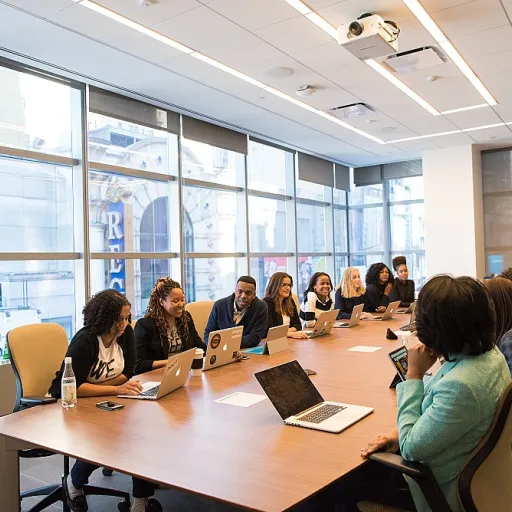
Understanding the impact of crowded workplaces on New Zealand offices
The reality of limited space in New Zealand offices
Many New Zealand businesses are feeling the squeeze as office buildings become busier and teams grow. The trend towards open-plan layouts and flexible work arrangements has led to more people sharing the same environment. While this can create a lively atmosphere, it also brings challenges for both management and employees. A crowded workplace can impact productivity, increase work stress, and make it harder for people to find free space for focused tasks or private meetings.
Why overcrowding matters for your team
When too many people are working in a limited area, the work environment can quickly become noisy and distracting. Workers may struggle to concentrate, and the constant movement of people walking busy corridors or talking in shared spaces can disrupt meetings and daily tasks. Overcrowding can also affect health and safety, as well as the overall well-being of your group. In a busy office, it’s easier for germs to spread, and employees may feel more stress due to a lack of privacy or personal space.
Business management and compliance considerations
For office managers, maintaining a professional and safe environment is a top priority. Overcrowding can make it harder to comply with workplace regulations and privacy policy requirements. It’s important to monitor warning signs such as increased sick leave, complaints about noise, or reduced productivity. Understanding these challenges will help you create a better work environment for your team and support your business goals.
For a deeper look at how workplace regulations can affect your office, you may find this article on understanding the implications of sick time regulations useful, especially when considering the health and safety of your employees in a crowded setting.
Recognizing early signs of overcrowding in your office
Spotting the Warning Signs of Overcrowding
In a busy office, it can be easy to overlook the early indicators that your workplace is becoming too crowded. Recognizing these signs early will help management take action before productivity and well-being are affected. Here are some common warning signs to watch for in your New Zealand business environment:
- Increased noise levels: More people talking, phones ringing, and general activity can make it hard for employees to concentrate.
- Lack of privacy: Workers may struggle to find a free space for confidential meetings or focused work, impacting both productivity and privacy policy compliance.
- Frequent interruptions: With people walking busy corridors and sharing limited space, distractions can rise, making it difficult to complete tasks efficiently.
- Reduced meeting room availability: Teams may find it challenging to book a meeting space, leading to delays and frustration.
- Visible clutter and stock overflow: Office supplies, files, or equipment may start to pile up, reducing the professional appearance of the workplace.
- Health and safety concerns: Overcrowding can increase the risk of accidents, especially in shared spaces or when emergency exits are blocked.
- Employee stress and absenteeism: A crowded workplace can lead to work stress, longer hours day after day, and even increased sick leave among employees.
Business management should regularly assess the work environment for these signs. If you notice a rise in complaints about the place work, or if your team is struggling to find quiet areas, it may be time to review your office layout and policies. For more on supporting employees when space is tight, exploring the benefits of light duty assignments can offer practical solutions for your group.
By staying alert to these early indicators, you can create a healthier, more productive working office for everyone in your building.
Strategies to optimize space without major renovations
Practical steps to maximise your office space
When your workplace starts to feel crowded, it can impact productivity, well-being, and even health safety. But you don’t always need a major renovation to make your office more comfortable for your team. With some smart business management and a focus on the needs of people working in your environment, you can optimise your space and reduce work stress.
- Rearrange furniture: Sometimes, simply moving desks or storage units can free up valuable space. Consider flexible layouts that allow people to move around more easily, especially in busy office areas where workers are often walking busy corridors.
- Adopt shared workstations: Hot-desking or hotel desk systems can help manage the flow of people in the office. This approach is especially useful for businesses with hybrid or flexible hours day arrangements. For practical tips, check out this guide on optimizing hotel desk operations.
- Declutter and manage stock: Regularly review what items are essential in your office. Remove or store away unused equipment, old files, or excess stock to create a more open work environment for your group.
- Use vertical space: Install shelves or wall-mounted storage to keep the floor area clear. This helps maintain a professional look and gives employees more free space for movement.
- Designate quiet zones: In a crowded workplace, privacy policy and focus are important. Set aside small areas for private calls or focused work, so people talking in meetings don’t disturb others.
These strategies will help your business create a healthier, less stressful place work for everyone. By making small changes, management can support both productivity and well-being, even when the building feels busy. Remember, recognising the warning signs of overcrowding and acting early is key to maintaining a positive work environment for all employees.
Supporting employee well-being in a crowded environment
Prioritising Mental Health and Reducing Work Stress
In a crowded workplace, stress can build up quickly. The constant movement of people, noise from busy offices, and lack of personal space can make it hard for employees to focus. Management should encourage open conversations about work stress and mental health. Providing access to professional support services, such as counselling or employee assistance programmes, will help workers feel valued and supported. Remind your team that it's okay to take breaks and step outside the building for fresh air, even during busy hours of the day.
Encouraging Flexible Work Arrangements
Not every task needs to be completed in the office. Allowing flexible hours or remote work options can ease the pressure on shared spaces and give people more control over their work environment. This approach benefits both business management and employees, as it helps balance workloads and reduces the feeling of being crowded. Consider rotating in-office days for different groups or teams to free up space and create a calmer atmosphere.
Promoting Healthy Habits and Safe Practices
Health and safety are essential in any busy office. Encourage employees to maintain good hygiene, especially when sharing equipment or meeting rooms. Make sure there are clear guidelines about the use of shared spaces, and display reminders about privacy policy and user agreement for shared digital tools. Stock the office with healthy snacks and provide free access to water to support well-being. Regularly review warning signs of stress or burnout among your team, and offer support when needed.
Building a Supportive Team Culture
Even in a crowded environment, people working together can create a positive atmosphere. Encourage group activities that foster connection, such as short team meetings or walking breaks. Recognise achievements and celebrate milestones to boost morale. When people feel part of a supportive team, the challenges of a crowded workplace become easier to manage. This focus on well-being will help your business thrive, even in a busy office setting.
Leveraging technology to ease the challenges of crowded workplaces
Smart tools for a smoother workday
In a busy office, technology can be a game-changer for both productivity and well-being. When people are sharing limited space, the right digital solutions help teams stay organised, reduce work stress, and keep business management running smoothly. Here are some practical ways technology will help your workplace adapt to a crowded environment:
- Desk booking systems: These allow employees to reserve workstations in advance, making it easier for management to track space usage and avoid overcrowding. This is especially useful for businesses with flexible hours day or hybrid work arrangements.
- Digital collaboration tools: Platforms for group chats, video meetings, and document sharing help people working in different parts of the building stay connected. This reduces the need for large, in-person meetings in a crowded workplace and supports a professional work environment.
- Noise-cancelling technology: Headphones and sound-masking devices can help workers focus, even when the office is busy and people talking are nearby. This small investment can make a big difference in reducing stress and boosting productivity.
- Smart scheduling apps: These tools help teams coordinate meeting times and room bookings, so no one is left walking busy corridors searching for a free space. It also helps management avoid double-booking and ensures everyone has access to the resources they need.
- Health and safety monitoring: Sensors and apps can alert management to warning signs of overcrowding, such as high CO2 levels or temperature spikes. This supports a safer work environment for all employees.
When implementing new technology, it’s important to consider privacy policy and user agreement requirements. Make sure your team understands how their data will be used and stored. By leveraging the right digital tools, your business can create a more efficient, less stressful place work—no matter how many people office together in the same building.
Fostering a positive culture despite limited space
Building Trust and Team Spirit in Tight Spaces
When your workplace feels crowded, it’s easy for stress to rise and for people to feel like just another face in a busy office. Yet, even in a packed environment, management can foster a positive culture that helps employees feel valued and connected. A strong team spirit can make a real difference in how people experience their hours each day, even when space is limited.
- Encourage open communication: Make it clear that everyone’s voice matters. Regular group meetings, even if brief, help people share concerns and ideas about the work environment and business management.
- Celebrate small wins: Recognise achievements, no matter how minor. A simple shout-out during a meeting or a thank-you note can boost morale among workers sharing the same space.
- Promote respect for shared spaces: Remind employees about the importance of tidiness and consideration in a busy office. Clear guidelines—like a privacy policy for shared desks or stock areas—help everyone feel comfortable.
- Support flexible work: If possible, offer options like remote work or staggered hours. This not only frees up physical space but also shows trust in your team’s professionalism.
Encouraging Well-Being and Connection
People working in a crowded workplace can sometimes feel isolated or overwhelmed. Management should look for ways to support well-being and reduce work stress, especially when warning signs appear. Consider these approaches:
- Provide quiet zones: Even a small corner can be set aside for employees needing a break from the busy environment.
- Organise group activities: Social events, even informal ones like shared lunches, help people connect beyond their daily tasks. This strengthens the sense of belonging in the office.
- Encourage movement: Remind employees to take short walks, whether inside the building or outside. Walking in a busy place of work can help clear the mind and reduce stress.
Leadership’s Role in a Positive Work Environment
Leaders set the tone for the workplace culture. By modelling positive behaviours—like active listening, fairness, and respect—management can inspire the whole team. Make sure to check in with employees regularly and address any concerns about the crowded office promptly. This will help maintain trust and a healthy work environment, even when space is tight.
Remember, a positive culture doesn’t depend on how much space you have, but on how people feel about coming to work each day. Prioritising health, safety, and connection will help your business thrive, no matter how crowded the office gets.












